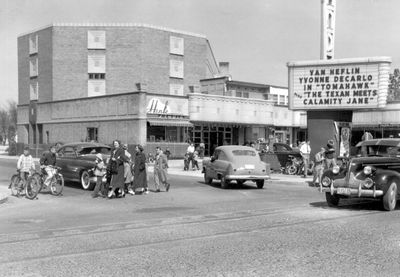Garland stories keep rolling

In an era when going to the movies pretty much means going to a multiplex at a mall, Spokane’s Garland Theatre survives as the city’s only remaining single-screen theater.
An encore (second-run) theater, the Garland at 924 W. Garland Ave., is probably the best known of the 80-plus properties in the Garland Business District. It is both a family- and budget-friendly venue with a rich history filled with human interest stories – including some recent ones.
When the theater opened in 1945, it was heralded as one of the premier examples of art deco architecture, not just in Spokane but in the Pacific Northwest. A story in The Spokesman-Review on Nov. 21, 1945, gave an account of the gala opening, which included an Army searchlight unit from Fort George Wright and a victory bond rally. The film that night was “It’s a Pleasure,” starring Sonja Henie.
In “A People’s History of the Garland Business District,” prepared in 2007 by Stephen Emerson of Archaeological and Historical Services at Eastern Washington University and the Spokane City/County Historic Preservation Office, it is noted that the stadium-type auditorium was finished in powder blue and had a seating capacity between 900 and 1,000. A special feature was the extra width between the rows, “which eliminates the necessity of rising when another person enters the row.”
The theater also contained three storefronts and had a residential penthouse on the second level, where the first manager, Charles Harris, and his wife, Lois, lived. Lois Harris operated a music store in one of the storefronts.
Possibly the best known of the businesses located at the Garland was the Henle Photo Studio, which became the Henle-Care Studio in the mid-1970s, operating there until 1988.
The theater itself was in operation until about 1986. Don Clifton purchased it in 1988 and reopened it as the city’s first discount theater. Katherine Fritchie bought the theater about 10 years ago “because I always liked that old theater and because I thought it would be a fun and good venture.”
She saw the sale listed in The Spokesman-Review classified ads.
The operating philosophy is simple: show lots of movies that are no longer playing at the first-run theaters and don’t charge much. The number of films showing each day varies, but on Fridays in the summers, there are seven different films, the last one showing at midnight. Also in summer, there is a free 9:30 a.m. show Monday through Friday.
“Those are shows aimed at kids,” Fritchie said. “Last week we had ‘Pink Panther 2,’ which drew about 320 people, and this week it’s ‘Inkheart.’ Sometimes we max out and have to close the doors.”
The theater tends to draw families, college students and a fair number of people on first dates, she added. Admission is $3.50, but there are some $1 events as well.
Though there have been upgrades and remodeling in the theater over the years, it remains very much like it was way back when – but maximum capacity is now just above 600. Fritchie said some seats were removed, and when new seats were installed, “well, as we get wider, so have the seats.” Many of the rows have maintained the original knee-room width that was so proudly featured in the building’s heyday.
There have been a number of special events in the building, including some weddings and marriage proposals. A wedding there last fall had a movie theme, at the end of which the curtain opened and credits ran on the screen – name of the bride and groom, the wedding party and other particulars. And, naturally, those in attendance threw popcorn as the couple left the building.
Fritchie recalls one memorable marriage proposal a few months ago. A schoolteacher planned a special night there for his girlfriend. But first he made a video using photos from her life growing up and their lives together, and he also enlisted his students to participate, filming each one holding up a card with a letter on it – together spelling out “Will You Marry Me?”
By special arrangement, the video played on the Garland’s screen.
“Not that there wasn’t a lot of pressure on her, what with all those people there watching, too, but I’m happy to say that she said yes,” Fritchie said.